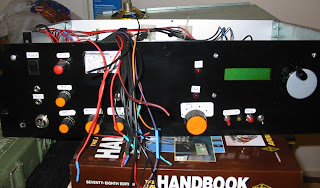
In the process of building one multiband transceiver from a mix of different designs I set for this bandpass filter: http://www.gqrp.org/technical1.htm.
Having the Toko coils getting dust for long it was time to start building it....
Case you didn't read some previous blog entry... I am out of stock in some components namely several low value capacitors....anyhow started to put some "cans" and making the first test in the 30m band, why? Because at 10.100 there is always there a big signal, if it's not, everything is closed :)
Placing the filter inline with my TS-50 I started to "tune" the coils for maximum signal at my interest frequency (10.102Mhz), it's one way of doing it, another way I already tested was with the antenna "analyzer" in the input and a 50 Ohm load on the output. Now the interesting part, I can get around 50 Ohm load on the meter (R=3 X=50) but SWR does not drop bellow 10.... I am missing something for shure...
Another possible test I did: Placed my homebrew noise generator ( It's the first time I use it for something except for checking it's working) at the input of the filter and then the ouput connected to the TS-50.... you can see the signal meter with only the noise generator and with the filter inline. 2 dashes lower in signal, should this be normal or not I would have to have the s-meter calibrated...tho see attenuation... etc...etc... well at least this filter is kind of working, further tests will be done at the end. Must read more about rf testing.
Direct connection of noise generator to radio:

The bandpass filter inline between noise generator and radio (best optimization on the filter built):

Now the big question is: are the Toko coils correctly placed (with the correct pinout, reading the schematic I think they are).... I can answer that but will have to invert pinout and make some more tests....if someone knows the answer please leave a comment.
p.s. Found the same schematic a little bit more explicit, I think my component placement is correct after all.
Schematic at: http://home.hetnet.nl/~gbakelaar/kank.jpg
































.jpg)
.jpg)







.jpg)
.jpg)